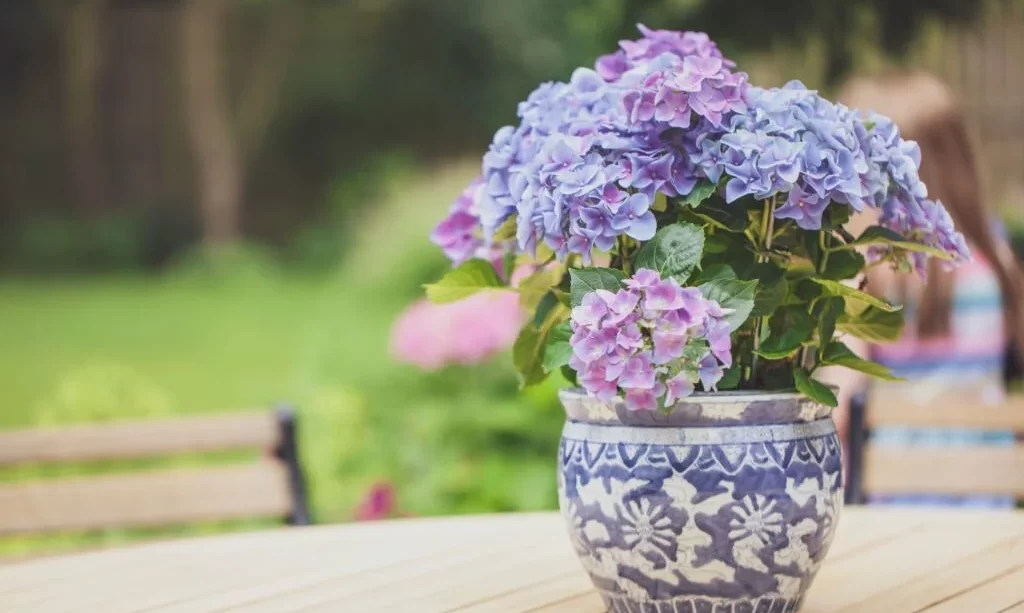Potted hydrangeas are like living ornaments, adorning our homes with their lush, colorful blooms. As the seasons change and the allure of outdoor gardening beckons, many plant enthusiasts wonder, “When can I put my potted hydrangea outside?” It’s a question that arises from the desire to see these beautiful plants grace our outdoor spaces with their stunning flowers. In this article, we’ll explore the considerations and timing for making this transition. While it’s tempting to move your potted hydrangea outdoors, it’s essential to understand the ideal conditions for their growth and to choose the right moment to do so. Let’s embark on this horticultural journey to ensure that your potted hydrangea thrives when it finds its place in your garden.
- Turns hydrangeas blue
- Lowers the pH of soils for optimum growth of acid-loving plants
- Derived from Elemental Sulfur & Gypsum
- Great for blueberries
- Safer than Aluminum Sulfate
The Hydrangea’s Ideal Environment
Before discussing when to move your potted hydrangea outside, it’s essential to understand the conditions that these lovely plants prefer. Hydrangeas thrive in well-drained soil with good fertility. They enjoy a balance of sunlight and shade, making them versatile garden additions. However, the specific needs of hydrangeas can vary depending on the variety you have. Some prefer full sun, while others thrive in partial shade. Knowing your hydrangea’s variety and its ideal growing conditions is crucial to providing the right environment for your plant. Additionally, hydrangeas appreciate consistent moisture but dislike waterlogged soil, so proper drainage is essential. Once you have a good grasp of your hydrangea’s requirements, you’ll be better equipped to decide when and where to place it outdoors.
Timing for Moving Potted Hydrangeas Outdoors
The timing for moving potted hydrangeas outdoors is a critical factor in their successful transition. In most cases, the best time to make this move is in the spring, typically after the danger of frost has passed. Frost can harm hydrangeas, particularly new growth, so it’s important to ensure that the threat of frost is minimal or gone entirely. Spring offers a suitable combination of milder temperatures and increased daylight, providing a favorable environment for your potted hydrangea’s growth. However, it’s essential to keep a close eye on local weather conditions in your area, as frost dates can vary. Some hydrangea varieties, like the oakleaf hydrangea, can withstand slightly cooler temperatures, while others, like the tender garden hydrangea, require warmer conditions. By aligning the transition with spring’s arrival and ensuring frost is no longer a concern, you’ll give your potted hydrangea the best chance to thrive when it joins the outdoor garden.
Preparing Your Hydrangea for the Move
Before you move your potted hydrangea outdoors, it’s important to prepare it for the transition. Start by examining the condition of your plant. Check for any dead or diseased branches, and prune them as needed. If your hydrangea has outgrown its pot, this may be an ideal time to consider repotting it to a larger container. This ensures that the plant has enough room to grow and thrive. Additionally, acclimating your hydrangea to the outdoor environment is essential. Begin by placing it in a partially shaded area outdoors for a few hours each day, gradually increasing its exposure to natural light and outdoor conditions. This process, known as “hardening off,” helps your hydrangea adapt to the new environment, reducing the risk of transplant shock. With proper preparation, your potted hydrangea will be better equipped to flourish in its new outdoor home.
Selecting the Right Outdoor Spot
Selecting the ideal spot for your potted hydrangea in your outdoor garden is crucial for its well-being. Hydrangeas thrive in a location with well-drained soil that retains moisture but doesn’t become waterlogged. If you’re planting in the ground, consider amending the soil with organic matter to improve its drainage and fertility. When it comes to light, most hydrangeas appreciate a balance between sunlight and shade. A spot that receives morning sunlight and afternoon shade is often ideal. However, the specific light requirements can vary based on the hydrangea variety you have, so take that into consideration. Avoid areas with strong winds or harsh exposure to the elements, which can damage the plant or dry out the soil. By carefully selecting the right outdoor location for your potted hydrangea, you create an environment where it can flourish and thrive.
Caring for Your Potted Hydrangea Outdoors
Once your potted hydrangea is comfortably settled in its outdoor spot, regular care is essential to ensure its continued health and beauty. Proper watering is crucial; hydrangeas like consistent moisture but not soggy conditions. Keep the soil consistently damp, but avoid waterlogging. Mulching the base of the plant can help retain moisture and prevent weed growth. Hydrangeas also benefit from periodic feeding with a balanced, slow-release fertilizer formulated for acid-loving plants. Pruning can be done after the plant finishes flowering, and it’s a good practice to remove spent blooms to encourage new growth. Additionally, be vigilant for pests and diseases and take appropriate measures if you notice any issues. By providing your potted hydrangea with these necessary care steps, you can ensure that it thrives in its new outdoor environment.
Conclusion
In conclusion, the timing and considerations for moving your potted hydrangea outdoors are vital for its success in your garden. By understanding the plant’s ideal growing conditions, timing the transition correctly, and preparing your hydrangea through pruning and acclimation, you set the stage for its flourishing outdoor life. Careful selection of the right outdoor spot and diligent attention to its needs, including watering, feeding, and pest control, are essential for long-term health and vibrancy. Moving your potted hydrangea outdoors is not just a change of location; it’s a commitment to nurturing its beauty and ensuring it thrives in your garden, providing you with delightful blooms year after year.





